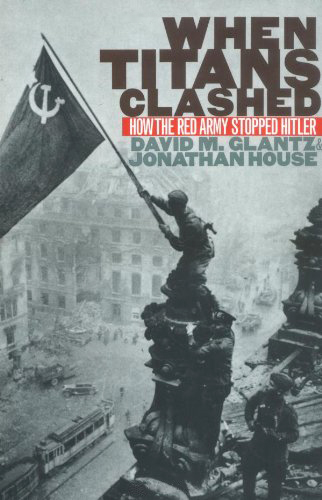By the time Pearl Harbor had ripped apart America's peacetime pretensions, the German blitzkrieg had already blasted the Red Army back to the gates of Moscow. Yet, less than four years later, the Soviet hammer-and-sickle flew above the ruins of Berlin, stark symbol of a miraculous comeback that destroyed the German army and shattered Hitler's imperial designs.
Told in swift stirring prose, When Titans Clashed provides the first full account of this epic struggle from the Soviet perspective. David Glantz, one of the world's foremost authorities on the Soviet military, and Jonathan House present a fundamentally new interpretation of what the Russians called the "Great Patriotic War." Based on unprecedented access to formerly classified Soviet sources, they counter the German perspective that has dominated previous accounts and radically revise our understanding of the Soviet experience during World War II.
Placing the war within its wider political, economic, and social contexts, the authors recount how the determined Soviets overcame their initial disasters to defeat the most powerful army ever assembled. As they vividly show, this truly was war waged on a titanic scale, sweeping across a half-million square miles from Moscow to Berlin, featuring monumental offensives and counteroffensives, and ultimately costing both sides combined a staggering forty million casualties.
Their work offers new revelations on Soviet strategy and tactics, Stalin's role as supreme commander of the Red Army, the emergence of innovative and courageous commanders in the crucible of combat, numerous previously concealed or neglected military operations, German miscalculations on the road to the Red capital, the effect of D-Day and the "second front" on the Soviet effort, and the war's devastating impact on the Soviet economy and civilian population.
An essential volume for anyone interested in World War II or Soviet history, When Titans Clashed will change forever how we look at one of the greatest military confrontations in world history.
This book is part of the Modern War Studies series.
The Battle of Moscow...
Related Scanning WWII dates...
- 02 Oct 41: Day 1 of 98Panzer Group 2 advances toward Moscow ahead of rest of Army Group Centre
- 11 Oct 41: Day 10 of 98Rumors of impending fall of Moscow cause thousands of civilians to flee
- 19 Oct 41: Day 18 of 98Army Group Centre captures 670,000 Russians, 1,000 tanks, 4,000 guns
- 27 Oct 41: Day 26 of 98Soviets launch counter-attacks around Moscow to halt the German advance
- 15 Nov 41: Day 45 of 98In temperatures of -20°C, German troops resume offensive against Moscow
- 25 Nov 41: Day 55 of 98German ground troops actually reach Moscow, but cannot sustain their attack
- 27 Nov 41: Day 57 of 98German Panzers are 19 miles from Moscow; armed patrols can see the Kremlin
- 29 Nov 41: Day 59 of 98German Army Group Centre's offensive in Russia begins grinding to a halt
- 02 Dec 41: Day 62 of 98German patrols are now just five miles from the Kremlin in Moscow
- 08 Dec 41: Day 68 of 98The Soviet offensive succeeds in breaking through the lines in many places
- 20 Dec 41: Day 80 of 98German troops have pulled back to more than 62 miles (100 km) from Moscow
- 07 Jan 42: Day 98 of 98Moscow is no longer under threat; the Battle of Moscow is over
Related WWII Store items...
- The Greatest Battle:
Stalin, Hitler, and the Desperate Struggle for Moscow That Changed the Course of World War II - The Defense of Moscow 1941:
The Northern Flank - When Titans Clashed:
How the Red Army Stopped Hitler
![]()



